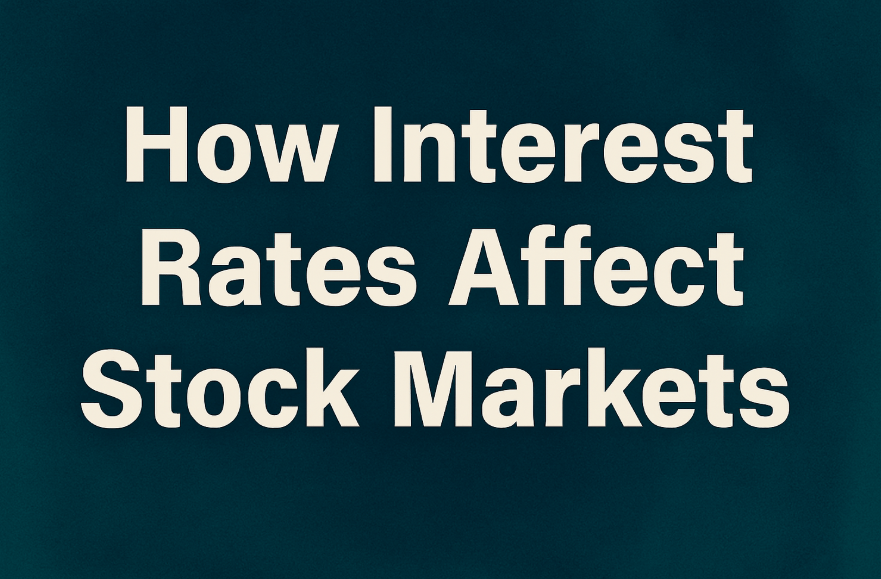- Live Life Grow Wealth
- Posts
- 🏦Series 6 Day 6: How Interest Rates Affect Stock Markets
🏦Series 6 Day 6: How Interest Rates Affect Stock Markets

Today’s Headline
🏦 Series 6: Advanced Topics (For Curious Learners)
Day 6: How Interest Rates Affect Stock Markets
Whenever the U.S. Federal Reserve or any central bank makes an announcement about interest rates, the stock market reacts — sometimes calmly, sometimes like a roller coaster. You’ll often hear headlines like “Stocks plunge as Fed hikes rates” or “Markets rally after rate cut.” But what exactly does this mean? Why does a simple number — the interest rate — have so much power over the entire stock market?
When I first started learning about investing, I used to ignore these news headlines. They sounded too technical, and I thought they only mattered to economists or bankers. But once I understood how interest rates actually shape the stock market, everything clicked. In fact, knowing how rates work gave me a huge advantage as an investor.
So in today’s issue, I’ll break this all down — in plain English — so you’ll never be confused again when you hear about rate hikes or cuts.
“Want smarter investing? This AI-chatbot tool turns website traffic into actionable data—see how it can sharpen your edge and boost your portfolio.”
Is your Shopify Brand ready for Agentic Commerce this Q4?
Agentic Commerce is transforming ecommerce.
Zipchat.ai is the AI Agent built for Shopify brands — converting visitors, recovering carts, and automating support 24/7. Trusted by Police, TropicFeel, and Jackery, it works whether you have 10k visitors/month or millions, so you can win Q4 without extra headcount.
Use code NEWSLETTER10 for 10% off forever.
What Are Interest Rates, Really?
At its core, an interest rate is simply the cost of borrowing money.
When you take a loan, you pay interest. When you save money in a bank, you earn interest. In both cases, the interest rate determines how much it costs (or rewards) you to use money over time.
For central banks, like the Federal Reserve (the Fed) or the Monetary Authority of Singapore (MAS), interest rates are tools — tools to control inflation, spending, and economic growth.
Think of interest rates as the gas pedal and brake of the economy:
When rates go down, borrowing becomes cheaper — that’s like pressing the gas pedal.
When rates go up, borrowing gets expensive — that’s like hitting the brakes.
And because money is the fuel that drives business activity, any change in rates affects everything — from housing loans to car prices to stock markets.
Why Central Banks Change Interest Rates
Central banks don’t change interest rates for fun. They do it to keep the economy balanced.
Here’s the simple logic:
When inflation is high, meaning prices are rising too fast — the central bank raises interest rates. This makes borrowing more expensive and slows down spending.
When the economy is weak, meaning unemployment is rising and businesses are struggling — the central bank cuts rates. This makes borrowing cheaper and encourages spending and investment.
Their goal is to keep things steady — not too hot, not too cold. Economists call this the “Goldilocks zone.”
But here’s where it gets interesting — these rate changes don’t just affect the economy. They also have a huge impact on the stock market.
How Higher Interest Rates Affect Stocks
When interest rates rise, the cost of borrowing money goes up.
That affects both companies and investors:
Companies Pay More for Loans
Businesses often borrow money to expand, hire, or invest in new projects. When rates go up, borrowing becomes more expensive, and profits shrink.
Lower profits mean lower stock prices.Investors Move to Safer Assets
When rates are high, investors can earn decent returns from bonds or savings accounts without taking stock market risks. So, they pull money out of stocks and move into fixed-income assets.
This “money shift” causes stock prices to drop.Valuations Fall
Higher interest rates reduce the “present value” of future earnings. In simple terms, investors care less about money they’ll earn 10 years later because they can earn good returns today with safer investments.
That’s why growth stocks — especially tech companies — often fall sharply when interest rates rise.
So, whenever you see the Fed raising rates, expect investors to become cautious. Stocks may fall, not because companies are bad, but because money itself just got more expensive.
How Lower Interest Rates Affect Stocks
Now let’s flip the situation.
When the central bank cuts interest rates, it’s like giving the economy a caffeine boost.
Here’s what happens:
Borrowing Becomes Cheaper
Companies can take loans easily to expand operations, build new projects, or hire more workers. This usually leads to higher profits down the road.Investors Search for Higher Returns
When savings accounts and bonds pay little interest, investors rush back to the stock market in search of better returns. That pushes stock prices up.Consumer Spending Rises
Cheaper loans mean people buy more homes, cars, and goods. When spending rises, businesses earn more — and that drives stock prices higher.
This is why you often see markets rally when the Fed announces a rate cut. Cheaper money means more economic activity — and more optimism.
The Chain Reaction: From Interest Rates to Stock Prices
Let’s visualize how one simple rate change causes a domino effect:
Step 1: Central bank changes interest rates.
Step 2: Banks adjust lending rates for loans, mortgages, and savings.
Step 3: Consumers and businesses change their borrowing and spending habits.
Step 4: Company profits go up or down depending on how expensive money becomes.
Step 5: Investors adjust their portfolios — buying or selling stocks.
Step 6: Stock market prices react accordingly.
It’s all connected. A small percentage change in interest rates can ripple through the entire economy.
Which Stocks Are Most Sensitive to Interest Rates?
Not all companies react to rate changes in the same way. Some thrive, while others struggle.
Here’s a quick guide:
1. Growth Stocks (Tech, Innovation, Startups)
These companies rely heavily on future earnings and often borrow money to grow fast.
When rates rise, they get hit the hardest.
2. Value Stocks (Banks, Utilities, Industrials)
These are established companies with stable profits and strong cash flow.
They tend to hold up better when rates rise.
3. Financial Stocks (Banks, Insurers)
Banks can actually benefit from higher rates because they earn more from loans.
However, if rates go too high, fewer people borrow — and that can hurt them too.
4. Real Estate Stocks (REITs)
These are very sensitive to interest rates since property investment depends on cheap loans.
Higher rates can lower demand for property and hurt REIT prices.
So, understanding how rates affect each sector helps you decide where to invest — and when to be cautious.
$1K Could’ve Made $2.5M
In 1999, $1K in Nvidia’s IPO would be worth $2.5M today. Now another early-stage AI tech startup is breaking through—and it’s still early.
RAD Intel’s award-winning AI platform helps Fortune 1000 brands predict ad performance before they spend.
The company’s valuation has surged 4900% in four years* with over $50M raised.
Already trusted by a who’s-who roster of Fortune 1000 brands and leading global agencies. Recurring seven-figure partnerships in place and their Nasdaq ticker is reserved: $RADI.
Now open at $0.81/share, allocations limited – price moves on 11/20.
This is a paid advertisement for RAD Intel made pursuant to Regulation A+ offering and involves risk, including the possible loss of principal. The valuation is set by the Company and there is currently no public market for the Company's Common Stock. Nasdaq ticker “RADI” has been reserved by RAD Intel and any potential listing is subject to future regulatory approval and market conditions. Investor references reflect factual individual or institutional participation and do not imply endorsement or sponsorship by the referenced companies. Please read the offering circular and related risks at invest.radintel.ai.
The Psychology Behind It
Markets aren’t just numbers — they’re driven by emotion and expectation.
Sometimes, stock prices move not because of what the central bank does, but because of what investors expect it will do next.
If investors think rates will go up soon, they start selling early.
If they think rates will go down, they buy in advance.
That’s why you’ll often see markets reacting even before an official announcement. It’s not about what happened — it’s about what people believe will happen next.
In investing, perception often becomes reality.
The Tug-of-War Between Inflation and Growth
To really understand interest rates, you have to understand the constant battle between inflation and economic growth.
If the economy grows too fast, inflation rises — and the central bank raises rates to cool it down.
If the economy slows too much, unemployment rises — and the central bank cuts rates to revive it.
This cycle never ends. It’s like balancing on a seesaw — too much pressure on one side, and the whole system tips.
For investors, this means you must always watch both sides:
How fast prices (inflation) are rising.
How fast businesses (growth) are expanding.
Interest rates are the bridge that connects these two.
Historical Examples
Let’s look at two simple examples:
1. 2020 – Pandemic Era (Low Rates)
During the pandemic, central banks around the world slashed interest rates to near zero. Money became incredibly cheap.
As a result, stock markets — especially tech companies — exploded. Investors could borrow cheaply and chase growth.
2. 2022–2023 – Rate Hikes to Fight Inflation
When inflation hit record highs, the Fed raised rates aggressively. Suddenly, cheap money disappeared.
Tech stocks crashed, and real estate slowed down. But value and defensive stocks held up better.
These two periods clearly show how rate changes directly shape market behavior.
How You Can Use This Knowledge
As an investor, you don’t need to predict interest rate changes perfectly. What matters is understanding how they affect your decisions.
Here’s how you can use this knowledge:
Watch Central Bank Announcements
Even one sentence from the Fed Chair can move markets. Learn to read between the lines — are they hinting at raising or cutting rates?Diversify Your Portfolio
Mix growth and value stocks. When rates rise, your value stocks can cushion the fall of your growth holdings.Don’t Panic During Rate Changes
Markets often overreact. Short-term volatility doesn’t always mean long-term danger.Focus on Quality Companies
Strong businesses with low debt and steady profits can survive any rate cycle.Think Long-Term
Rates will go up and down over time — that’s part of the game. What matters is how disciplined you are through each cycle.
My Personal Experience
I remember once during a rate hike cycle, I panicked and sold my tech stocks because the news kept saying “market crash ahead.” A few months later, those same stocks rebounded strongly as inflation cooled.
That experience taught me something priceless: don’t make decisions out of fear — make them out of understanding.
Interest rates will always change. But if you know how they work, you’ll never be blindsided again.
Key Takeaways
Interest rates are the cost of borrowing money, controlled by central banks.
When rates rise, borrowing becomes expensive — slowing spending and hurting stock prices.
When rates fall, borrowing becomes cheap — boosting economic activity and lifting stocks.
Growth stocks are more sensitive to rate changes than value stocks.
Always balance your portfolio and think long-term through every rate cycle.
Final Takeaways
Interest rates might seem like just numbers in a headline — but in reality, they are the heartbeat of the financial world. They decide how much people spend, how much companies invest, and how much your portfolio grows.
The more you understand them, the better your decisions will be.
So the next time you see news about the Fed, don’t scroll past it. Pause. Ask yourself: How will this affect company profits, investor sentiment, and my investments?
That’s how smart investors think — not emotionally, but strategically.
Stay tuned for tomorrow’s issue, where we’ll go even deeper into how global events shape your wealth-building journey.
Until then, stay curious, stay informed, and always invest with intention.
[Live Life Grow Wealth]
🎓 Free Masterclasses to Unlock Your Investment Potential
Take your money skills to the next level with expert-led workshops designed to help you grow smarter and faster.
Recommendations Section
“Peek into smart money moves — when big players act, you’re in the loop.”
|
Learn simple, proven ways to grow your money — straight from real investors who walk the talk.
|
“Hone your investing edge in just 5 minutes — smart, snappy insights to power your portfolio growth.”
|
“Stay ahead with one expert-picked stock monthly — clear, no jargon, built for growth.”
DISCLAIMER
I make no representations, warranties, or guarantees, whether expressed or implied, that the content provided is accurate, complete, or up-to-date. Past performance is not indicative nor a guarantee of future returns.
I am an individual content creator and not regulated or licensed by the Monetary Authority of Singapore (MAS) as I do not provide investment services.
All forms of investments carry risks, including the risk of losing your entire invested amount. Such activities may not be suitable for everyone. You are strongly encouraged to seek advice from a professional financial advisor if you have any doubts or concerns.








